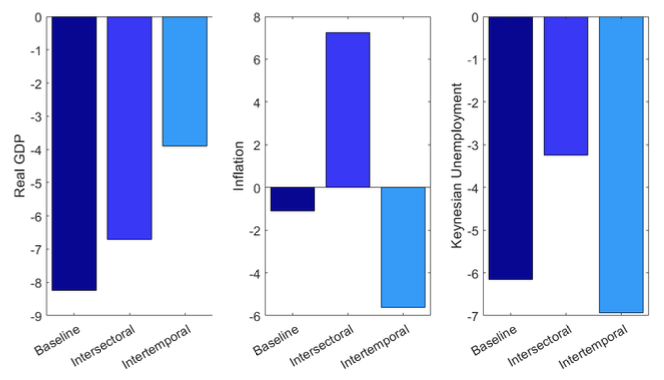Both reductions in supply and demand lower real GDP. However, for policymakers, separating demand shortfalls from supply constraints is important because they require different remedies. Treatments for inadequate demand – such as lowering interest rates or increasing in government spending – exacerbate problems of inadequate supply, leading to shortages and inflation. Similarly, treatments for inadequate supply – such as relaxing lockdowns or providing liability exemptions – applied to demand-constrained sectors are ineffective at restoring activity.
Most recessions are broad-based in the sense that all sectors reduce their output simultaneously. Accordingly, the basic textbook macroeconomics model, the AS-AD model, aggregates all sectors of the economy into one. To tell supply and demand shocks apart in this model, one need simply look at the behaviour of the price level. If output falls and the price level rises, there was an aggregate supply shock. On the other hand, if output falls and prices fall, then there was an aggregate demand shock.
Many analysts forecast that real GDP will fall by around 10% in the second quarter of 2020. However, in the data, the price level has barely moved. Both CPI and PCE inflation rates were very slightly negative from March to May. Even after accounting for the fact that some goods became unavailable (Jaravel and O’Connell 2020), the response of inflation has been muted. A simple AS-AD model suggests that, therefore, there must have been a negative aggregate supply and a negative aggregate demand shock, resulting in large movements in real GDP with minimal changes in the price level.
Unfortunately, the basic AS-AD model reaches this conclusion by making radical, perhaps misleading, simplifications. Unlike ordinary recessions, where depressed economic activity is broad-based and prices move in tandem, the Covid-19 crisis affected output and prices differently in different sectors. Although almost all sectors reduced production, some sectors raised prices while others cut prices.
To analyse this situation of divergent outcomes, in a recent paper (Baqaee and Farhi 2020), we develop a model of the economy that accounts for heterogeneous sectors, supply chain networks, segmented labour markets, downwardly rigid wages, the zero lower bound, and a rich set of supply and demand shocks.
We calibrate the model and estimate the negative sectoral supply shocks, the shocks to the sectoral composition of household demand, and the shocks to the intertemporal composition of household demand, using the available data on US household expenditures and employment by industry for February to May. We use this framework to disentangle the supply and demand drivers of the recession (Baldwin 2020, Brinca et al. 2020, Goodhart and Pradhan 2020).
In the model, the production network, and substitution by consumers and producers in the production network, determines how sales are allocated across markets, and which sectors lose more demand than supply and become demand constrained in response to the Covid-19 shock. Some sectors, such as oil, are constrained by demand since demand for their goods, either directly by households or indirectly by downstream sectors, fell. At the same time, other sectors, such as restaurants or movie theatres, are constrained by supply since they were legally obligated to shut down in many states at the height of the lockdown or forced to operate at reduced capacity.
Although our model has many sectors, labour markets, and supply chain networks, it nevertheless admits an AS-AD representation. Using this representation, we show that the broad logic of the basic AS-AD model continues to apply in more realistic settings. In particular, negative sectoral supply shocks and shocks to the intersectoral composition of household demand are both stagflationary. On the other hand, negative shocks to the intertemporal composition of household demand (aggregate demand shocks) are deflationary.
A purely intersectoral view of the drivers of the recession – that is, one with only negative sectoral supply shocks and shocks to the sectoral composition of demand – is untenable. These shocks, even though they would endogenously trigger further reductions in employment through Keynesian channels, would generate 7% inflation, reduce real GDP by 7%, and leave nominal GDP almost unchanged, where all these numbers are cumulated from February to May.
Similarly, a purely aggregate demand driven explanation is also problematic. In our model, a pure negative aggregate demand shock would cause 6% deflation, reduce real GDP by 4%, and reduce nominal GDP by 9%.
The combination of the two types of shocks, intersectoral and intertemporal, creates movements in inflation, and real and nominal GDP that are consistent with the data, that is, close to zero inflation and a reduction of around 9% in real and nominal GDP.
These findings are illustrated in Figure 1, which displays real GDP, inflation, and Keynesian unemployment in the baseline model as well as what would happen with only intersectoral or intertemporal shocks.
Figure 1 Cumulated percent change since February 2020 of real GDP, inflation, and Keynesian unemployment under the baseline model as well as with only intersectoral and intertemporal shocks
Our baseline also replicates the cross-industry patterns in hours worked. Although almost all sectors have experienced reductions in hours, in some sectors, these reductions are due to supply constraints whilst in others they are due to demand shortfalls. We refer to employment reductions in demand-constrained sectors as Keynesian unemployment. This bounds the amount of slack in the economy that would disappear if demand were higher. Figure 1 shows that the combination of intersectoral and intertemporal shocks in the baseline model leads to significant Keynesian unemployment of 6%. By contrast, Keynesian unemployment is only 3% with only intersectoral shocks and as much as 7% with only intertemporal shocks.
The model allows us to classify employment reductions in each sector as being demand- or supply-driven. Examples of sectors that are supply constrained (and their reduction in hours from February to May) include food services and accommodations (−39%), food and beverage products (-8%), motion pictures (−53%), and construction (−9%). For these sectors, we interpret the reduction in hours in these sectors to be driven by state-mandated lockdowns and social distancing orders that were in effect during our sample period as well as voluntary reductions in capacity to ensure that production and consumption are safe.
Examples of sectors that are demand constrained are transportation industries, such as air transportation (−39%), water transportation (−30%), rail transportation (−18%), petroleum and coal (−18%), and oil and gas extraction (−17%). The reduction in demand in these sectors reflects the fact that households reduced their expenditures on transportation sectors, and, directly and indirectly through the production network, those sectors that are reliant on fossil fuels.
As a check on the model, we compare recovery in hours by sector from April to May. We find that those sectors that the model classified as being demand-constrained in April 2020 recovered on average 1.8%, whereas those sectors classified as supply-constrained recovered by 7.5%. This suggests that supply constraints were relaxed faster than demand constraints as the economy started to recover in May. It also underscores the fact that conditions are changing rapidly and differentially across sectors, so that sectors that are supply-constrained in April could easily be demand-constrained in June.
Of course, during the pandemic, some reductions in economic activity are unavoidable and perhaps desirable for public health reasons, but others are avoidable and undesirable. Separating the two is a difficult but vital problem for successful public policy. In particular, even taking as given health-related reductions in productive capacity, there is an important role for demand management in order to minimize unemployment in demand-constrained sectors.
Despite the presence of 6% Keynesian unemployment, the sectoral nature of the Covid-19 crisis implies that traditional recession-fighting tools are likely blunted. We find that untargeted aggregate demand stabilisation would increase real GDP by only half of what it would in a more typical recession driven entirely by a reduction in aggregate demand. Since some sectors are already operating at capacity, untargeted demand stimulus, while desirable, is in part dissipated in price increases. Targeted policies that stimulate spending in demand-constrained sectors deliver better bang for buck.
References
Jaravel, X, and M O'Connell (2020), "Inflation Spike and Falling Product Variety during the Great Lockdown."
Baqaee, D, and E Farhi (2020), “Supply and Demand in Disaggregated Keynesian Economies with an Application to the Covid-19 Crisis”.
Brinca, R, J B Duarte and M Faria e Castro (2020), “Decomposing demand and supply shocks during COVID-19”, VoxEU.org, 17 June.
Baldwin, R (2020), "The supply side matters: Guns versus butter, Covid-style," VoxEU.org, 22 March.
Goodhart, C A E and M Pradhan (2020), "Future imperfect after coronavirus", VoxEU.org, 27 March.




